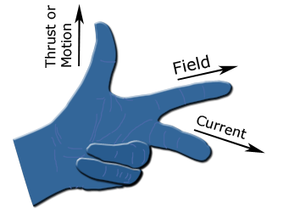
Back قاعدة فليمنغ لليد اليسرى Arabic Vimkol (Crocidura muricauda) AVK Sol əl qaydası Azerbaijani Regla de la mà esquerra Catalan Flemingovo pravidlo levé ruky Czech Regla de la mano izquierda Spanish Vasaku käe reegel Estonian Règle de la main gauche French फ्लेमिंग वामहस्त नियम Hindi Pravilo lijeve ruke Croatian
This article needs additional citations for verification. (November 2011) |

Fleming's left-hand rule for electric motors is one of a pair of visual mnemonics, the other being Fleming's right-hand rule for generators.[1][2][3] They were originated by John Ambrose Fleming, in the late 19th century, as a simple way of working out the direction of motion in an electric motor, or the direction of electric current in an electric generator.
When current flows through a conducting wire, and an external magnetic field is applied across that flow, the conducting wire experiences a force perpendicular both to that field and to the direction of the current flow (i.e. they are mutually perpendicular). A left hand can be held, as shown in the illustration, so as to represent three mutually orthogonal axes on the thumb, fore finger and middle finger. Each finger is then assigned to a quantity (mechanical force, magnetic field and electric current). The right and left hand are used for generators and motors respectively
- The direction of the electric current is that of [conventional current]: from positive to negative.
- ^ Fleming, John Ambrose (1902). Magnets and Electric Currents, 2nd Edition. London: E.& F. N. Spon. pp. 173–174.
- ^ Electrical4U. "Fleming's Left And Right Hand Thumb Rules Explained". www.electrical4u.com/. Retrieved 2021-03-22.
{{cite web}}: CS1 maint: numeric names: authors list (link) - ^ "Fleming's left-hand rule – Higher - Magnetic effects of currents and the motor effect - Eduqas - GCSE Physics (Single Science) Revision - Eduqas". BBC Bitesize. Retrieved 2021-03-22.
© MMXXIII Rich X Search. We shall prevail. All rights reserved. Rich X Search